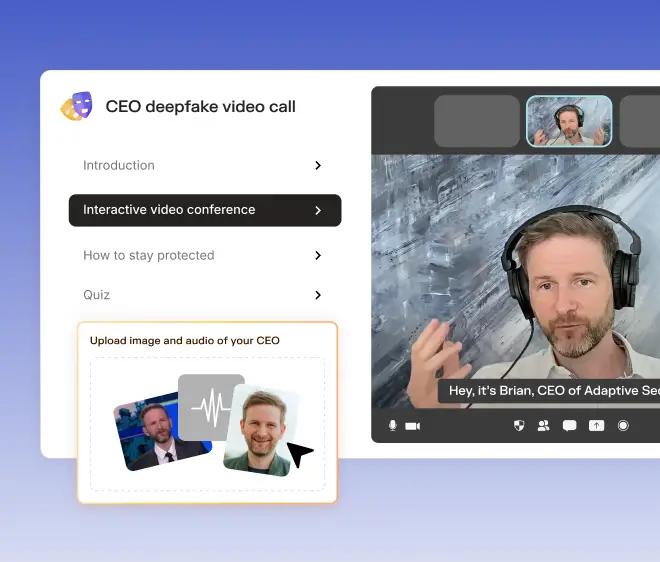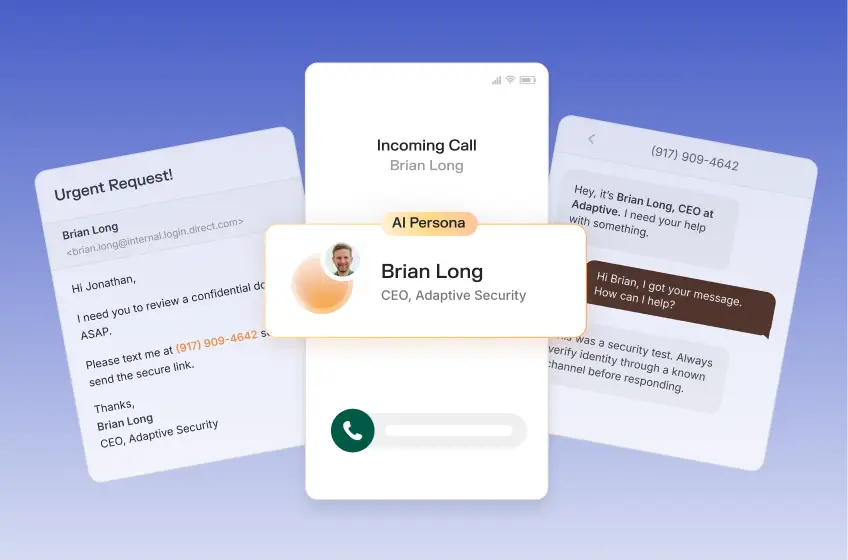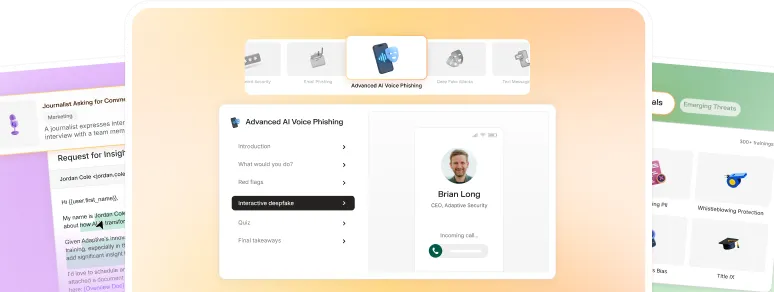Imagine receiving an email from your CEO on a Friday afternoon. It’s marked urgent. It has a link to a doc they need you to approve right now. You click the link and are taken to a page that looks legit. But it’s not. You’ve just interacted with a phishing kit.
Phishing attacks aren’t just single hackers sending typo-ridden emails — they’re industrialized. Phishing kits have turned social engineering into a scalable business, helping cyber criminals launch sophisticated attacks with little effort. At least a quarter of all global cyber attacks are phishing attempts, and are an enormous problem for modern businesses.
This article demystifies phishing kits, explores recent threats that bypass even multi-factor authentication (MFA), and explains why training people — not just deploying tech — is the key to resilience. We’ll also explore how Adaptive Security helps organizations simulate these exact threats, so teams can recognize them when it matters most.
What is a phishing kit?
A phishing kit is a ready-made collection of software designed to help attackers quickly launch and manage phishing campaigns. They are like DIY crimeware packages.
Each kit typically includes:
- Fake website pages that mimic banks, SaaS tools, or enterprise apps (typically login pages).
- Scripts that log credentials.
- Command-and-control dashboards for attackers to monitor success.
These kits are often sold on dark web marketplaces or Telegram (a cloud-based messaging app) groups, bundled with a slick, point-and-click user experience. Some even include customer support.
Because of advanced kits like this, training that only teaches employees to spot typos doesn’t stand a chance against phishing kits that clone websites down to the last detail.
What do phishing kits include?
The goal of modern phishing kits is data collection, whether it’s gathering credit card information, phone numbers, or company login credentials. All kits include the basic components that make launching and scaling an attack easy — even for non-technical threat actors.
Credential harvesting pages
This is a form of domain spoofing, and an integral part of any phishing kit. These phishing pages are designed to be indistinguishable from legitimate login portals and mimic the branding, layout, and even URL structure of services like Microsoft 365 and Google Workspace.
Some even display fake error messages to prompt users to try again, capturing multiple entries for even more password information. This attack is typically the first step in a malicious multi-prong attack where criminals will steal data, disrupt systems, or commit identity theft and financial fraud.
Email templates and lure kits
Attackers no longer need to write their own scams. Phishing kits often bundle dozens of pre-written email templates crafted with urgency, authority, or fear in mind. These templates mimic messages like:
- IT notifications
- HR requests
- Financial services updates
- Executive directives
Some templates even include personalized fields that auto-fill based on scraped data, making the lure hyper-specific to the target.
Automation scripts
Automated phishing tools help criminals mass produce emails and other messages. These kits come with scripts that automate sending thousands of emails, rotating sender addresses, and tracking delivery and open rates. Some even include CAPTCHA bypass and geolocation filters to target specific regions or user types.
Admin dashboard
Some phishing kits are extremely sophisticated and allow attackers to manage attacks in real time. They can view captured data and manage operations via slick web-based dashboards with this software.
These dashboards show who clicked what, when, and where. They can also export stolen credentials, configure new campaigns, and deploy updates to phishing pages with a few clicks, similar to legitimate marketing platforms.
Why phishing kits are so effective
Phishing kits don’t just trick systems — they exploit people. These attacks are grounded in social engineering techniques that target predictable human behaviors, such as:
- Urgency: Messages often demand immediate action. "Your account will be locked in 5 minutes."
- Authority: The email appears to come from a senior executive or IT administrator.
- Scarcity: "Only the first 50 employees to respond will retain access."
- Routine: People are used to clicking links in emails without question, especially if they mimic daily workflows.
Psychological manipulation makes phishing kits highly effective even against tech-savvy individuals. Under pressure, even trained employees will ignore their better critical thinking. Modern phishing kits also rival legitimate software in UX and polish.
Common features include HTTPS with valid SSL certificates, mobile optimization (ensuring phishing pages render cleanly across all devices), real logos, and multi-language support. These tools lower the barrier to entry, so attackers don’t need coding skills. They just click launch.
Certain technology, like generative AI and LLMs, is now being used to craft:
- Flawless, personalized emails with dynamic fields (e.g., first name, company name, department)
- Context-aware phishing copy that mimics internal jargon or recent events (e.g., "update to your Q3 bonus form")
- Multilingual campaigns targeting global workforces
AI makes phishing scalable and harder to detect. Unlike past campaigns filled with poor grammar and sentence structure, today’s lures are virtually indistinguishable from legitimate business messages.
For example, man-in-the-middle (MitM) phishing kits sit between the victim and the real site, proxying their interactions. When a user enters credentials and MFA codes, they’re passed to the legitimate site, granting the attacker access.
Notable methods include real-time session hijacking, token theft for SSO platforms, and the use of transparent reverse proxies to stay undetected. This undermines multi-factor authentication, one of the strongest technical defenses, and demonstrates why user behavior must be part of the security equation.
Adaptive Security's training platform simulates these advanced tactics, helping prepare employees for advanced phishing. Users face real-world scenarios, MFA interception, AI-crafted lures, and lookalike domains, allowing them to develop real-world instincts.
Real phishing kits in the wild: recent case studies
Understanding how phishing kits operate in real-world scenarios is crucial for building effective defenses. These are recent incidents that reveal how modern phishing kits bypass technical controls and exploit human behavior.
EvilProxy
EvilProxy is a phishing kit used to bypass MFA. In one notable incident, victims received phishing emails impersonating Microsoft login requests. Many of these emails exploited open redirect vulnerabilities on legitimate domains, such as Indeed.com, to bypass detection and redirect users to malicious login pages.
EvilProxy functions as a reverse proxy, sitting between the victim and a real login page to intercept credentials, 2FA codes, and session cookies. Once users enter their information, attackers can hijack sessions in real time.
- Target: Senior executives and high-value employees across sectors, including banking, financial services, real estate, and manufacturing. U.S.-based firms were heavily targeted in campaigns beginning in mid-2023.
- Impact: Credentials stolen through EvilProxy enabled attackers to take over accounts, access cloud environments, and conduct internal reconnaissance. Microsoft attributed some campaigns to the group Storm-0835, which sells access to EvilProxy under a monthly subscription model ($200–$1,000/month).
EvilProxy illustrates the rise of BEC 3.0, where attackers use trusted platforms, social engineering, and advanced proxy kits to bypass traditional defenses. Security awareness must evolve to include detection of redirect-based attacks and pressure-driven tactics, especially among senior leaders.
Tycoon 2FA
Tycoon 2FA is another example of an effective phishing kit. This malware uses SMS messages to mimic IT departments, instructing employees to click on a secure login portal for "mandatory reauthentication." The portal uses a transparent reverse proxy to relay credentials and OTP codes to the actual login server in real time.
- Target: Employees of multinational corporations using Okta for single sign-on (SSO).
- Impact: Credential theft led to successful takeovers of internal systems and email accounts, with some breaches undetected for days.
Smishing (SMS phishing) campaigns that use realistic messaging and link masking can be just as effective as email. Awareness training must include multi-channel threats.
Adaptive can help defend your org against kit-based attacks
Phishing kits weaponize natural human behavior, and organizations need security measures that go beyond basic simulations. Adaptive Security simulations are rooted in threat intelligence and real-world phishing mechanics. The platform mirrors tactics used by kits and deploys phishing lures across email, SMS, voice, and even deepfake visuals.
Unlike static training methods, Adaptive’s training evolves. It adjusts based on employee behavior, role, and risk score, reinforcing learning through realistic and repeated exposure.
Most importantly, organizations using Adaptive see measurable improvement in their security posture, especially among high-risk teams, through sustained click reduction and increased phishing report rates.
Security isn’t about one-time training. It’s about readiness. Book a demo now to test your team against today’s most advanced phishing kits.
FAQs about phishing kits
How are phishing kits distributed?
Phishing kits aren’t sold at your big box store; they’re found on the dark web, the unindexed part of the internet accessed with special software. Its sites run on the darknet, and traffic is almost always encrypted. Phishing kits are distributed there through cyber criminal networks.
Can phishing kits bypass MFA?
Some phishing kits are incredibly simplistic, while others are more advanced. These have real-time interception tools to steal MFA tokens, especially through man-in-the-middle attacks.
Are phishing kits illegal?
Phishing is a type of fraud and is illegal in many countries, including the United States. Creating, selling, or distributing phishing kits may not be explicitly outlawed, but it is illegal under general fraud legislation.
What’s the best way to defend against phishing kits?
Combine behavior-focused training with realistic simulations. Adaptive Security mimics real phishing kits, email, SMS, and AI-driven attacks, to train employees on what modern threats actually look like.




As experts in cybersecurity insights and AI threat analysis, the Adaptive Security Team is sharing its expertise with organizations.
Contents




.avif)



.avif)
%20(1).avif)